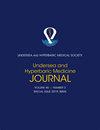高压氧治疗小儿脑放射性坏死
IF 0.7
4区 医学
Q4 MARINE & FRESHWATER BIOLOGY
引用次数: 0
摘要
脑放射性坏死是一种罕见的儿科疾病。本病例报告描述了一个使用皮质类固醇、贝伐单抗和高压氧成功治疗脑放射性坏死的儿童。病例报告:一名3岁男孩在完成神经上皮恶性肿瘤放射治疗6个月后出现进行性四肢无力。开始使用皮质类固醇和贝伐单抗治疗,但他的症状没有改善,随后他被转介进行高压氧治疗。在完成60次高压氧治疗后,他的活动能力得到了显著改善,并在接下来的一年中保持稳定。讨论:脑放射性坏死通常表现为儿童共济失调或头痛的症状。皮质类固醇和贝伐单抗是常见的治疗方法,但高压氧治疗也被研究作为这种疾病的治疗方式。在儿科患者中考虑使用高压氧时,仔细注意治疗计划和患者安全,可以降低中耳气压伤和禁闭焦虑等不良事件的风险。结论:在现有的药物治疗方法之外,应考虑高压氧合治疗儿童脑放射性坏死。本文章由计算机程序翻译,如有差异,请以英文原文为准。
Treatment of pediatric cerebral radiation necrosis using hyperbaric oxygenation
Introduction: Cerebral radiation necrosis is a rarely encountered in pediatric patients. This case report describes a child with cerebral radiation necrosis who was successfully treated using a corticosteroids, bevacizumab, and hyperbaric oxygenation. Case Report: A 3-year-old boy developed progressive extremity weakness six months after completion of radiation therapy for treatment of a neuroepithelial malignancy. Treatment with corticosteroids and bevacizumab was initiated, but his symptoms did not improve, and he was then referred for hyperbaric oxygen therapy. After completion of 60 hyperbaric treatments, he experienced significant improvements in mobility which remained stable over the next year. Discussion: Cerebral radiation necrosis typically presents in children with symptoms of ataxia or headache. Corticosteroids and bevacizumab are common treatments, but hyperbaric oxygen therapy has also been studied as a therapeutic modality for this condition. When considering the use of hyperbaric oxygenation in pediatric patients, careful attention to treatment planning and patient safety can reduce the risks of adverse events such as middle ear barotrauma and confinement anxiety. Conclusion: Hyperbaric oxygenation, in addition to other available pharmacologic therapies, should be considered for the treatment of pediatric patients with cerebral radiation necrosis.
求助全文
通过发布文献求助,成功后即可免费获取论文全文。
去求助
来源期刊

Undersea and Hyperbaric Medicine
医学-海洋与淡水生物学
CiteScore
1.60
自引率
11.10%
发文量
37
审稿时长
>12 weeks
期刊介绍:
Undersea and Hyperbaric Medicine Journal accepts manuscripts for publication that are related to the areas of diving
research and physiology, hyperbaric medicine and oxygen therapy, submarine medicine, naval medicine and clinical research
related to the above topics. To be considered for UHM scientific papers must deal with significant and new research in an
area related to biological, physical and clinical phenomena related to the above environments.
 求助内容:
求助内容: 应助结果提醒方式:
应助结果提醒方式:


